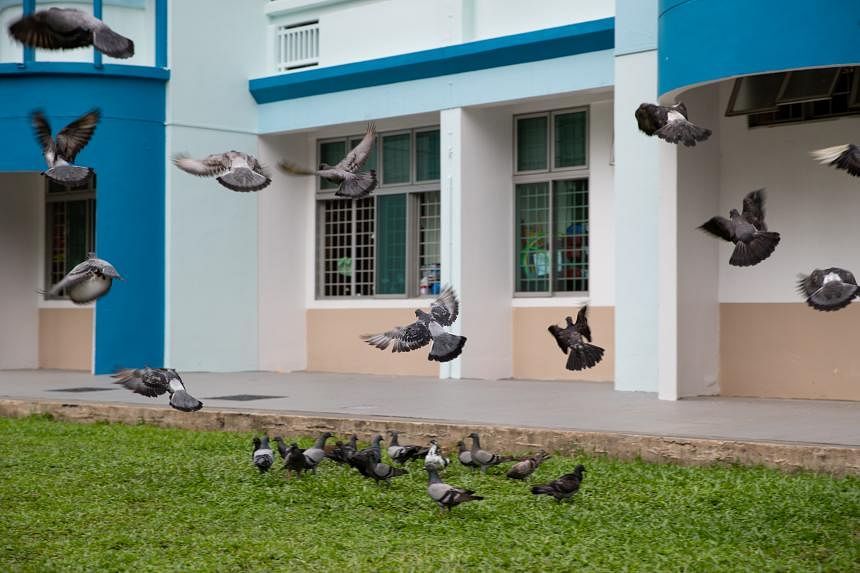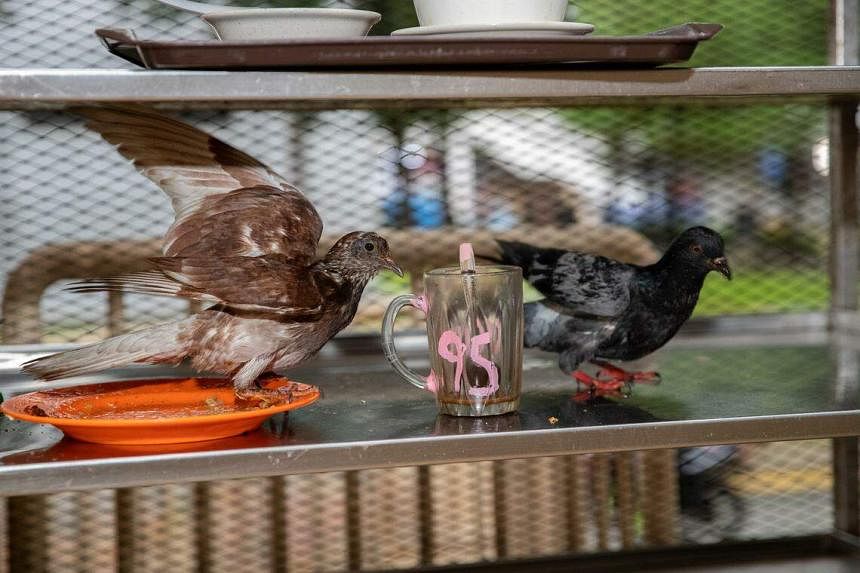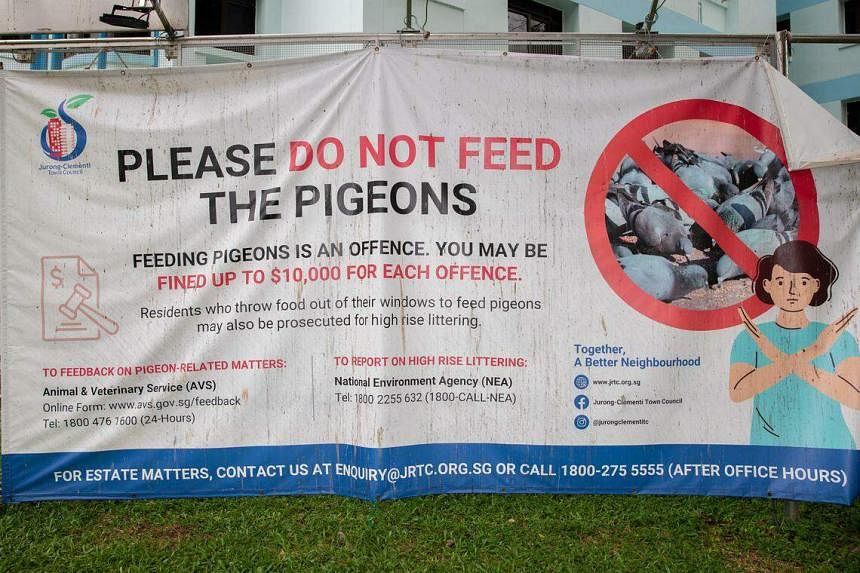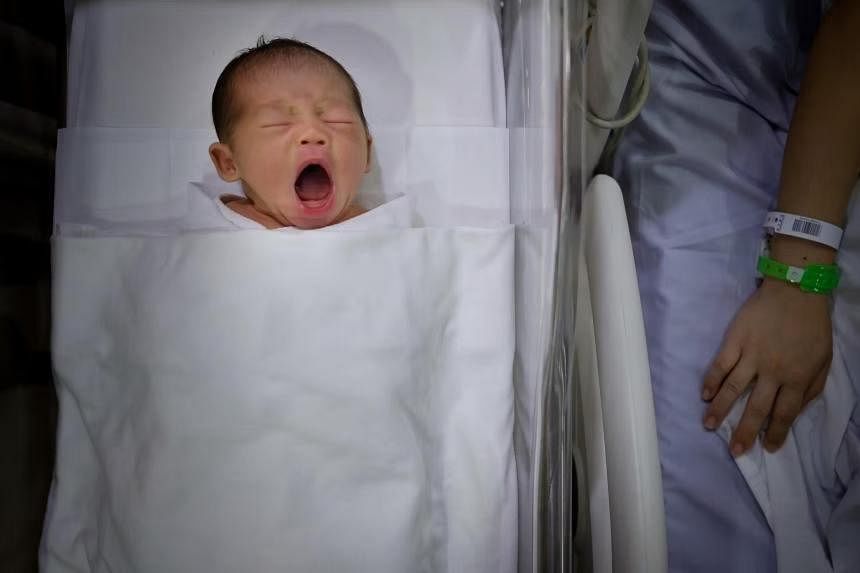‘They fly in the minute I sit down’: Acres, residents want more policing against bird feeding

NParks has received 7,016 cases of pigeon-related feedback in 2023 as at Nov 20. ST PHOTO: YONG LI XUAN
Carmen Sin and Yong Li Xuan
DEC 11, 2023
SINGAPORE – At a quiet housing estate in Jurong West, the floors beneath some blocks are splattered in white and green.
The perpetrators – a flock of more than 40 pigeons – crowd a nearby grass patch. They share the space with a large banner – streaked with droppings – warning against feeding the birds.
Reports of pigeons being a nuisance have peppered the news for months, with residents in places such as Jalan Kayu, Bukit Panjang and Sengkang complaining of “poop like rain”, soiled walls, and irksome chirping.
While data from the National Parks Board (NParks) suggests that the problem has improved in recent years, there have been calls from some quarters to increase enforcement against bird feeders.
This is especially since the availability of food is seen as the main cause of pigeons flourishing.
Rock pigeons, like Javan mynas and house crows, are an invasive species – not native to Singapore – and pose a threat to our native biodiversity, said NParks.
But serious diseases caused by pigeons are rare.
“Pigeons may cause some bacterial and fungal infections in humans, but these rarely result in serious disease. So far, avian influenza viruses have not been found in pigeons, so the risk of getting flu from them is minimal,” said Dr Yvonne Su of the Duke-NUS Medical School’s Emerging Infectious Diseases Programme.
NParks has received 7,016 cases of pigeon-related feedback in 2023 as at Nov 20. There were 7,039 such complaints in 2022, and 8,313 the year before. There were 7,601 complaints in 2020, when more people stayed home due to the Covid-19 pandemic, and 8,430 in 2019.
The board has recorded 170 cases of enforcement action against illegal bird feeding in 2023 as at Nov 20, compared with 233 in 2022, 185 in 2021, and 68 in 2020.
Under the Wildlife Act, offenders can be fined up to $5,000 for their first offence of feeding any wild animal and up to $10,000 for subsequent offences.
Mr Willie Tan, a resident of Kang Ching Road in Jurong West for 27 years, said he was fed up with recalcitrant feeders.

There have been news reports of pigeons being a nuisance, with their droppings dirtying the walls and floors. ST PHOTO: YONG LI XUAN
“There’s a guy who feeds the pigeons three times a day every day. My neighbours and I have filed many complaints, more than five, but it hasn’t stopped,” said the 58-year-old Grab driver.
Pointing out the bird feed that lined the corridor outside a childcare centre at the foot of one block, he added: “I’ve seen kids picking up the food out of curiosity. It’s bacterial.
“Now there’s a flock of 30 to 40 (birds) and they’re an eyesore. Where there are birds, there’s poop.”
In July, a 67-year-old Singaporean man was fined $4,800 for four charges of feeding pigeons, with another 12 taken into consideration. He was previously fined for a similar offence.
Aside from the problem of bird feeders, pigeons flock to hawker centres in search of food as well.
Madam Ong, who runs a food stall at the Old Airport Road hawker centre, said pigeons usually peck at leftovers on the tray return rack near her stall, and sometimes push cups and utensils off the rack, breaking things and making a mess.
Some even swoop in on food left unattended on the tables, the 60-year-old said.
Animal Concerns Research and Education Society (Acres) co-chief executive officer Anbarasi Boopal agreed that enforcement could be “more intensive for feeding of wildlife”.
Global and local studies have shown that reducing food sources is the best way to bring down the population, she said.

Leftover food in food centres are a source of food for pigeons, with the availability of food seen as the main cause for these birds flourishing. ST PHOTO: YONG LI XUAN
A study published by NParks in 2021 showed that an islandwide reduction in food provided by humans, due to social restrictions during the Covid-19 pandemic, resulted in a decline in the numbers of rock pigeons.
They devoted more time to foraging for food and spent less time resting, which would have repercussions on their reproductive capacity, according to the study.
“NParks monitors feedback on illegal bird feeding and undertakes active enforcement, which includes physical surveillance and the deployment of CCTV cameras at identified feeding hot spots,” said NParks director of wildlife management and outreach How Choon Beng.
When reporting such activity, detailed information – such as date, time, location and videos or photos – would be useful in helping NParks identify and engage the feeders, he added.
Enforcement action against feeders is one of several ways the board tackles this issue.
For example, NParks partners the Agency for Integrated Care, Municipal Services Office, People’s Association and town councils to understand the motivations of repeat offenders and discourage them from continuing to feed wildlife, according to the Ministry of National Development (MND) in a written reply to a parliamentary question in November.
“For example, some may feed wildlife due to loneliness, or because they are concerned that the animals are not getting enough food in the wild,” said MND.

Even a banner, asking the public not to feed the pigeons, is not spared from pigeon droppings ST PHOTO: YONG LI XUAN
NParks engages different groups within the community, such as the young through talks in school and the elderly through presentations and interactions with its staff, the board said.
These are part of the board’s science-based approach to mitigate issues concerning birds that are seen as pests, which also includes habitat modification, as well as culling. Since April 2019, the board has reduced culling operations in relation to such complaints, reported The Straits Times in 2020.
Culling had been the dominant means of pest bird control but proved ineffective, with complaints about the number of birds increasing by 140 per cent between 2014 and 2020.
Ms Boopal of Acres said these new, non-lethal measures may result in the reduction of the pigeon population in five years if carried out “intensively”, although the disruption caused by the Covid-19 pandemic may delay the effect.
A Nee Soon Town Council spokesman said: “The reality is, while these approaches have been partially effective, human behaviours such as continued errant feeding and food littering are difficult to eradicate.
“The problem will not go away by adopting a single approach but mitigated through collective effort with the community.”
To soften the impact of these birds on the cleanliness of public places, some town councils have stepped up their cleaning efforts, among other measures.
Mr Lim Biow Chuan, MP for Mountbatten, said the town council has installed bird spikes on beams and bird nettings around the Old Airport Road hawker centre, which is located in his constituency.
“These measures are implemented to discourage pigeons from perching in the area, thereby minimising the overall pigeon population,” he said.
“We have also taken steps to enhance cleanliness within the premises. The cleaners have been informed to intensify efforts in clearing and cleaning dishes on tray return racks, to prevent birds from feeding on leftover food.”
In the meantime, those in afflicted areas will have to contend with the problem in the best way they can.
Mr Vetharethinam Vairavanathan, who works at an Indian food stall in the Old Airport Road hawker centre, told ST he has resorted to using a laser pointer at the birds that gather on the rafters of his stall, on parts of the overhead piping at the food centre not lined with spikes.
“The minute I sit down for my break, they fly in,” the 52-year-old lamented. “It’s hard to rest.”









